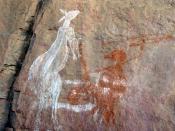Theatre is always a reflection of society at the time it is created and Contemporary Australian Theatre does not differ from this guideline. Gary's House by Debra Oswald and No Sugar by Jack Davis are two Australian plays which deal with issues relevant to the time of their creation.
No Sugar is set in 1929 and deals with issues predominantly associated with the hardships Aboriginal people had to face in that era. The play looks at discrimination, culture, identity, experience and the mistreatment of Aboriginal people and intends to educate the audience about these themes. The play also sets out to persuade the audience to judge these events from a perspective different from their own.
No Sugar achieves this aim by employing not only many dramatic forms and conventions but by also acting the play through naturalism. Naturalism allows No Sugar to not come across as artificial but instead an authentic Aboriginal play.
The inclusion of mixed English and traditional pastimes adds to this authenticity, overall creating a stronger belief that No Sugar is a realistic play that deals with real and relevant themes.
Like many other Aboriginal plays, No sugar juxtaposes the different values upheld by Aboriginal people and white people. It portrays the way Aboriginal people are required to fit into a white man's world. This is especially conveyed through Act 4 Scene 1 where Sister Eileen attempts to educate Topsy and Cissie about Christian religion.
The title of the play also reflects the hardships Aboriginal people had to accept. "Munday, let me give you a piece of advice: sugar catches more flies than vinegar," (Act 1 Scene 7). This displays how Aboriginal people were expected to withstand abuse without fighting back or standing up for themselves. It primarily reflects the lack of significance Aboriginal people had in...


